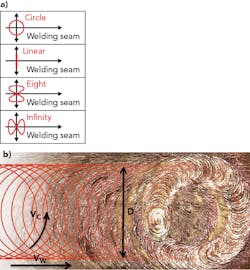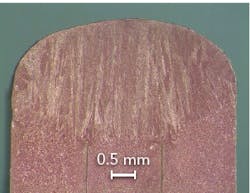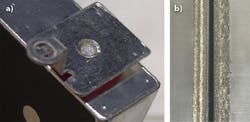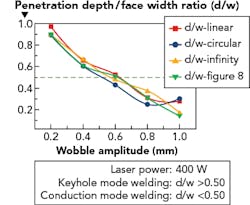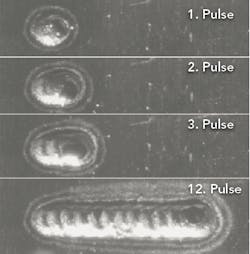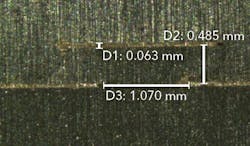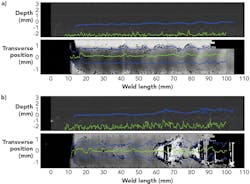Recent advances in fiber laser welding
Fiber laser welding continues to extend its reach across materials and applications. Innovations in laser technology and beam delivery components are overcoming traditionally challenging applications for laser welding, such as welding copper, dissimilar materials, thin metal foils, or poorly fit-up parts.
Fiber lasers are available with an increasing range of beam characteristics, wavelengths, laser powers, and pulse durations. Together with advanced wobble welding techniques, they have shown promise on alleviating such concerns by improving coupling into high-reflectivity materials, improving solidification behavior of the melt pool, eliminating defects, and improving penetration depth control while also compensating for poor part fit-ups.
Furthermore, integrated process monitoring technology such as inline coherent imaging (ICI) allows for collecting a wealth of information in real time during the welding process, helping manufacturers to keep a tight control on quality and improve productivity. These enabling technologies collectively are helping fast adoption rates for defect-free laser welding in advanced applications for a variety of industries.
Standard welding heads are designed to focus a collimated laser beam to a required spot size, keeping the beam path static through the beam delivery and a static spot at the focal plane. This standard configuration limits each setup to a specific application. Wobble heads, on the other hand, incorporate scanning mirror technology inside a standard weld head. By moving the beam with internal mirrors, the focal spot is no longer static, and can be dynamically adjusted by changing the shape (FIGURE 1a), amplitude, and frequency of various patterns. The beam velocity vccan be controlled by the wobble frequency f and wobble diameter D, with vc = π D f.
The frequency settings that provide the best results depend on the spot size, wobble diameter (and thus the circular speed vc), and linear welding speed. While the effective beam velocity also depends on the weld linear velocity vw, in most cases the beam velocity vc is much higher than the welding speed vw determining the weld dynamics (FIGURE 1b). In addition, this welding technique is compatible with standard coaxial nozzles and assist gas ports, which enable plume suppression and help control spatter techniques that are not readily compatible with the scan heads used in remote welding.
Benefits of this wobble approach are amplified when a smaller spot size is used. The smaller spot sizes achieve tremendous power density, overcoming high reflectivity in materials such as copper and aluminum when using near-infrared (near-IR) wavelengths to create a stable keyhole with a wide process window, and to avoid porosity and weld cracking when optimal wobble parameters are used. This has opened up new applications for e-mobility and battery manufacturing with 1 µm fiber lasers, eliminating the need for frequency-doubled green lasers.
Continuous-wave welding
With the development of new battery technologies and higher capacities, demands for joining technologies are increasing. The e-mobility sector is especially driving this trend and the automotive industry, and its suppliers are looking for robust and efficient welding processes for high-volume production of copper and aluminum joints that are extensively required in electric-vehicle (EV) batteries and electrical power storage products.
The challenges of laser welding copper and copper alloys are because of two major physical properties of the material—low absorption for most industrial high-power laser types and high heat conduction during the process. The absorption of near-IR lasers on solid copper at the beginning of the process is very poor at just 4% and, consequently, coupling into the material is difficult. Absorption of laser energy at shorter wavelengths such as green lasers at 532 nm is high, but high laser powers required for deep penetration welding or industrially proven lasers at this wavelength are not yet available.
Single- and low-mode near-IR 1 µm fiber lasers provide answers for this, as these lasers can be focused to spots as small as 20 µm, with a 1 kW single mode laser allowing for power densities above 1 MW/cm2. With this high power density, the lack of absorption can be overcome rapidly and the absorption of the molten or evaporated copper increases up to more than 60% to establish a stable keyhole.
Another issue in copper welding is instability because of low viscosity and surface tension of the melt, which can lead to spatter and blowholes when welding at low speeds.1 Increasing speeds above 10 m/min minimizes these instabilities and the process becomes stable. However, this means that the best weld parameters are in a range where conventional motion systems such as robots reach a limit. Besides this, penetration depth decreases with increasing speed and the weld gets very narrow. This must be compensated with increasing laser power, which requires higher capital investment for the system technology.
New process investigations have shown that this can be avoided and the process can be stabilized not just by increased speed in the welding direction, but also by a dynamic positioning technique, such as that achieved with wobble heads.2 This wobble technique allows stable welds at low linear welding speeds with minimum impact on penetration depth. For example, it is possible to achieve high-quality copper welds up to 1.5 mm deep with only 1 kW power from a single-mode fiber laser (FIGURE 2).Weld shaping
Job shops and manufacturers often run a variety of parts and need the flexibility to achieve unique weld requirements for each of these parts. Varying the wobble diameter can provide benefits of changing weld width and depth without changing any optics or defocusing the beam. For a constant energy input, weld shape changes (FIGURE 4) from a traditional nail head to a rectangular profile as the amplitude of oscillation increases. This control allows tailoring of the weld cross-section and, for example, can be used in cell connectors for high-power battery packs to generate a large weld contact area, which reduces resistance in the weld joint and provides a mechanically sound joint.Laser welding requires a high level of part fixturing and joint preparation, but it is very common to see parts that have poor fit-ups that need to be laser-welded. The beam wobble technique has proved valuable in alleviating part fit requirements, allowing a 2–3X increase in the acceptable seam gap and offset when compared with conventional laser welding. Applications include welding tubes to plates for making heat exchangers or welding large parts with poor edge preparation.
Long-pulsed welding
In continuous-wave (CW) welding, the absorption hurdle needs to be overcome just once. However, in pulsed welding, this needs to happen for each pulse, meaning that each pulse must couple into material before the next pulse arrives. In a static pulse process, pulse shaping with sophisticated individual pulses is required for a good process, but finding the right balance in pulse profile, pulse energy, and exposure time can be a challenge. The wobble technique is not just limited to CW lasers, and benefits can be realized also when applied to pulsed lasers such as millisecond quasi-CW fiber lasers. This technique creates a continuous and dynamic weld, moving the beam a long distance during each pulse to create a quasi-continuous stable weld.
FIGURE 7 illustrates a 20-ms-long pulse at a 600 Hz wobble frequency, leading to 12 rotations of the beam during the pulse duration to create a circular spot or linear weld, depending on the weld linear velocity and laser repetition rate. Adding pulse by pulse to a linear seam weld allows copper and aluminum pulsed welding with high weld quality at very low average power, which can be critical for welding of heat-sensitive components. Solidification and re-melting behavior from pulse to pulse takes place without weld defects, such as blow holes or intensive spatter, and the process is faster than traditional pulsed welding.Micro-pulsed welding
Trends toward more functionally dense consumer products and medical devices led to interest in joining dissimilar metals. As devices shrink, the challenge is to weld 150 μm or thinner foils with ever-greater precision. Traditional dissimilar metal foil welding is limited by the interfacial formation of brittle intermetallic phases, which ruin weld ductility. It can also be quite challenging to weld with a CW laser or millisecond pulsed regime, even with a wobble technique.
Using microsecond- to nanosecond-range pulses, the required pulse energy is delivered in smaller packets rapidly. When coupled with increased peak power, they produce high melt efficiency and stable welds. Using this technique, dissimilar metal foil welding with pulse durations ranging from 100 ns to 1.5 µs has shown excellent strength in foils welded that were fast and cosmetically acceptable with no mark on the back of the weld. This new technique adds to an expanding toolbox for welding dissimilar metals, which previously included single-mode CW and millisecond quasi-CW lasers.
FIGURE 8 depicts a stitch-welded joint between 100 µm stainless steel and 125 µm aluminum. The high degree of weld penetration control enables superior cosmetics, alongside a strong bond formed at a linear scan speed of 80 mm/s. The high speed possible with high-repetition-rate fiber lasers minimizes heat input, which contributes to the excellent aesthetics while fully avoiding any distortion of the very thin metal foils.Polymer welding
While ytterbium fiber lasers with 1064–1070 nm wavelengths excel in welding metal substrates, they are also being used to weld clear polymers to metals, using high-speed galvanometer scanners to control heat input and melting of the relatively transparent polymer at the absorbing metal interface. Thulium-doped fiber lasers operating at 2 µm are also gaining wide acceptance, as they address not only polymer-to-metal, but also polymer-to-polymer welding. Strong hermetic bonds have been demonstrated between polycarbonate to stainless steel, failing in the polymer at 400 N, as well as similarly strong bonds between polycarbonate or high-density polyethylene (HDPE) to titanium, and HDPE to nitinol (FIGURE 9).At 2 µm, the laser radiation is absorbed by many clear polymers, allowing for controlled heating throughout the thickness of the polymer and successful “clear-to-clear” polymer welding with adequate absorption on both sides of the weld, minimizing clamping requirements. Weld widths in the 0.1–5 mm range have been demonstrated in amorphous polymers (polycarbonate and polymethyl methacrylate) as well as semicrystalline materials (HDPE, low-density polyethylene, and polypropylene), resulting in high-lap weld strength. This opens the door to replacing slow adhesive-curing bonding processes in polymers with fast, high-precision laser bonding.
Weld monitoring and process control
Whether welding small medical parts in high volume or critical high-value components, weld monitoring and process control plays a key role in any production environment. Traditional process monitoring techniques rely on indirect measurements, can be impacted by the process, and still need destructive testing of parts, as they do not provide a direct weld depth measurement. Such techniques do not provide an accurate picture of weld defects along entire welds.
Adapted from established medical device imaging, ICI is an advanced in-process quality monitoring and control technology that can directly measure weld penetration, and provide a wealth of other information in real time and in any rugged industrial production setting. ICI is based on interferometry, and adds a low-power, near-IR measurement beam to the existing laser head delivery camera ports that is directed quasi-coaxially into the welding keyhole to directly measure penetration depth with high precision (~20 µm) and high speed (>200 kHz). The measurements are not affected by the high-power laser or plasma, and enable accurate measurement of weld depth in real time during the welding process.
Process data such as keyhole depth, seam profile, workpiece height, finished weld surface height, and bead profile can be extracted from a single instrument within seconds. The automatic weld measurements captured from this technology match the data that is generated by using traditional methods of part cross-sectioning and measurement. FIGURE 10 shows good and bad welds captured with the IPG LDD700 unit integrated to a standard welding head.Fiber lasers offer a broad range of beam characteristics, laser powers, wavelengths, and pulse duration regimes. Innovative approaches enabled by advances in fiber laser technology, combined with new techniques such as beam wobbling, overcome difficulties typically seen with traditional laser welding methods, and show great potential for further advances in welding technology.
REFERENCES
1. S. Liebl, R. Wiedenmann, A. Ganser, P. Schmitz, and M. F. Zaeh, Phys. Procedia, 56, 591–600 (2014).
2. D. Walter, B. Schmieder, and V. Moldovan, Laser Tech. J., 11 (2014).
Marco Mendes | Director of Laser Applications Engineering, IPG Photonics - Materials Processing Systems Division
Marco Mendes is director of laser applications engineering at IPG Photonics – Materials Processing Systems Division (Marlborough, MA).
Brian Baird | Senior Technologist, IPG Photonics
Brian Baird is a senior technologist at IPG Photonics (Oxford, MA).
Michael Grupp | Applications Manager, IPG Laser GmbH
Michael Grupp is an applications manager at IPG Laser GmbH (Burbach, Germany).
Vijay Kancharla | Applications Manager, IPG Photonics
Vijay Kancharla is an applications manager at IPG Photonics (Oxford, MA).
